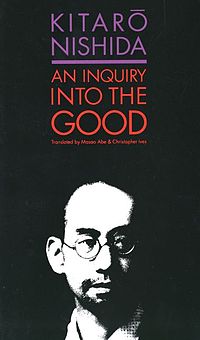 Cover of an English translation Cover of an English translation | |
| Author | Kitaro Nishida |
|---|---|
| Original title | Zen no kenkyū |
| Language | Japanese |
| Subject | Ethics |
| Published |
|
| Publisher |
|
| Publication place | Japan |
| Media type | |
| ISBN | 978-0300052336 |
An Inquiry into the Good, also known as A Study of Good, (Japanese: 善の研究) is the first book by the Japanese philosopher Nishida Kitarō, published in 1911.
As he explains in the Preface to the work, Parts II and III were composed first, followed by Parts I and IV. Part I is an explication of the nature of what he calls ‘pure experience’ which lies at the basis of his thought. Part II is the expression of his philosophical thought and is the core part of this book. Then, with the foundation being thus laid, Nishida launches into a discussion of the good in Part III. He appended Part IV out of his belief that the end of philosophy is religion. The reason that he entitled this work An Inquiry into the Good, despite half of it being devoted to the discussion of technical points in philosophy, is because he thought that, ultimately, the central focus of this work is the great questions of human life and existence.
Table of Contents
- Part I: Pure Experience
- Chapter 1: Pure Experience
- Chapter 2: Thought
- Chapter 3: Will
- Chapter 4: Intellectual Intuition
- Part II: Reality
- Chapter 1: The Point of Departure for Our Enquiry
- Chapter 2: The Phenomena of Consciousness Are the One Reality
- Chapter 3: The True Nature of Reality
- Chapter 4: The True Reality Always Has the Same Form
- Chapter 5: The Fundamental Formula of the True Reality
- Chapter 6: The One Reality
- Chapter 7: The Development of Reality by Differentiation
- Chapter 8: Nature
- Chapter 9: Spirit
- Chapter 10: God as Reality
- Part III: The Good
- Chapter 1: Action (Part 1)
- Chapter 2: Action (Part 2)
- Chapter 3: The Freedom of the Will
- Chapter 4: An Enquiry into Values
- Chapter 5: Theories of Ethics (Part 1)
- Chapter 6: Theories of Ethics (Part 2)
- Chapter 7: Theories of Ethics (Part 3)
- Chapter 8: Theories of Ethics (Part 4)
- Chapter 9: The Good (The Action Theory)
- Chapter 10: The Good of Personality
- Chapter 11: The Motivation of Good Action (The Form of the Good)
- Chapter 12: The End of Good Action (The Content of the Good)
- Chapter 13: The Perfect Good Act
- Part IV: Religion
- Chapter 1: The Religious Demand
- Chapter 2: God
- Chapter 3: God and the World
- Chapter 4: Knowledge and Love
Influence and reception
Graham Parkes described An Inquiry into the Good as a "masterpiece". He wrote that was made possible by the Japanese interest in western philosophy that began with the Meiji Restoration of 1868. He considered the book "path-breaking" and identified it as Nishida's best-known accomplishment.
The religious studies scholar Ninian Smart stated that An Inquiry into the Good "struck many readers as the first truly creative work by a Japanese that did not merely repeat western ideas, and yet made use of modern thinking and terminology." However, he added that the work was criticized by the philosopher Takahashi Satomi, who found the subjectivism of "pure experience" too psychological.
References
- 西田幾多郎「序」同『善の研究』岩波書店、1979年
- Parkes 2005, pp. 458, 659.
- Smart 2008, pp. 426, 430.
Bibliography
- Editions
- Nishida Kitarō, An Inquiry into the Good , ed. Fujita Masakatsu (Tokyo: Iwanami Shoten , 2012).
- Fujita’s notes in this edition are invaluable in tracking down Nishida’s allusions to the authors and works that influenced him.
- Nishida Kitarō, An Inquiry into the Good , ed. Kosaka Kunitsugu (Tokyo: Kōdansha , 2006).
- Kosaka, the leading scholar of Nishida’s philosophy, provides ample notes to aid especially the beginner. The two essays by Kosaka at the end, especially the one on the influence of Neo-Confucianism in this work, are essential reading.
- Books
- Take’uchi Yoshitomo , ‘The Formation of An Inquiry into the Good’ in Nishida Kitarō (Tokyo: University of Tokyo Press , 1970).
- Take’uchi’s treatment here of the influence of Wang Yangming’s school of Neo-Confucianism on An Inquiry into the Good is a classic.
- Shimomura Toratarō , ‘Nishida Kitarō’ in The Collected Works of Shimomura Toratarō, Vol. 12: Nishida’s Philosophy and Japanese Thought (Tokyo: Misuzu Shobō , 1990).
- The editor of Nishida’s Collected Works who studied under Nishida himself delves into the intellectual background and formation of Nishida, leading up to An Inquiry into the Good.
- Fujita Masakatsu (ed.), A Century of An Inquiry into the Good: To/From the World (Kyoto University Press , 2011).
- Parkes, Graham (2005). "Japanese philosophy". In Honderich, Ted (ed.). The Oxford Companion to Philosophy, Second Edition. Oxford: Oxford University Press. ISBN 0-19-926479-1.
- Smart, Ninian (2008). "China, Korea and Japan in modern times". In Leaman, Oliver (ed.). World Philosophies, Revised Second Edition. London: Routledge. ISBN 978-0-415-41189-9.
External links
- The Kōdōkan edition (1911) available at the National Diet Library’s Digital Collections website (N.B. their copy of this edition has pages missing).
- The Iwanami Shoten reprint (1921) available at the National Diet Library’s Digital Collections website (N.B. the type had been reset for this reprint, so the page numbers differ from the 1911 edition; this edition also includes a brief new preface).
- The 2nd edition (1936) from Iwanami Shoten available at the National Diet Library’s Digital Collections website (N.B. the type had been reset once more, so the page numbers differ again; this edition includes a new preface).
- The text of the Iwanami Bunko edition of 1979 available at Aozora Bunko (N.B. for this text the orthography has been updated to that of modern Japanese).